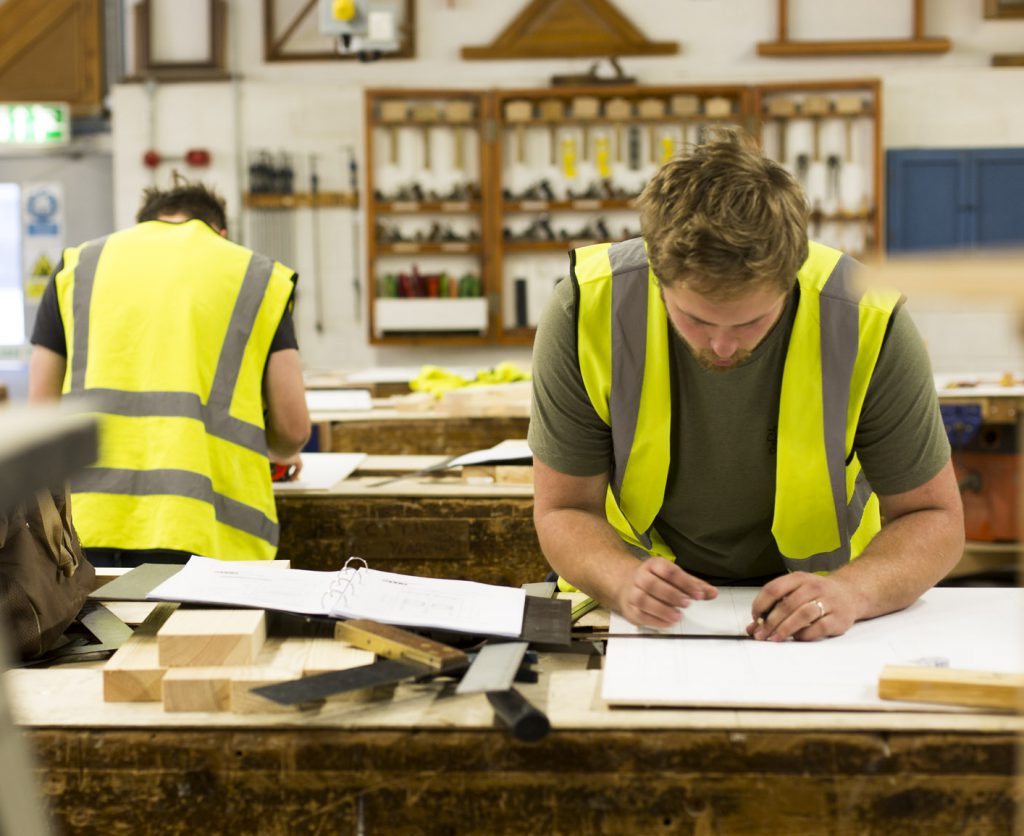Carpentry and Joinery – Site Carpenter Apprenticeship Level 3
Area
School Leavers ⓘThis course is also available under
Adult Learning
Apprenticeships
Subject
Construction
Campus
Duration
-
Select date to apply
Add to Shortlist
Course Overview
Begin your apprenticeship journey at BTC by applying for an apprenticeship on our website or through our prospectus form. Please apply for a full-time course as your second option. Then, have a look at relevant vacancies by visiting our vacancy page . If you haven’t found a suitable vacancy, you will automatically be placed into our Talent Pool.
As a member of our Talent Pool, you will be the first to hear about new vacancies and we offer support with CVs, interview techniques, employability skills and much more!
An Advanced Site Carpenter normally works on a building site or in domestic and commercial premises, preparing and installing complex and often bespoke building components eg. high quality doors, shaped linings, staircases with turns, complex wall and floor units, erecting bespoke structural carpentry (inclined roofs and joists) and erecting complex roof structures (eg. inclined roofs with hips, valleys and dormers). The occupation involves carrying out advanced skilled work, primarily using timber products, either on a construction site, or in a workshop, creating and installing building components. The advanced carpenter and joiner is able to undertake complex job tasks, requiring high levels of practical skills and knowledge, in addition to managing their own work and leading small teams.
The main differences between a Level 2 Apprenticeship and Level 3 Advanced Apprenticeship is that the Advanced Carpenter/Joiner has responsibility for managing their own and other peoples work, as well as being required to complete complex and non-standard work. Examples of complex tasks include curved products, irregular joints and bespoke work.
Units could include:
- English and maths
- Understand the technical principles of advanced site carpentry, such as effective and appropriate installation practices, being able to apply this knowledge in preparing and fixing complex, non-standard timber based products and components, such as erecting inclined roofs, making, assembling and erecting complex roof structures, including hip and dormer cut roofs, maintaining and repairing non-standard joinery products
- Understand how to carry out advanced calculations and work out cutting angles for complex carpentry work such as using a roofing square to calculate roof spar lengths and using a sliding bevel to mark out splayed joints
- Understand how to form complex joints associated with advanced site carpentry work,such as splayed and plumb
- Utilise a range of advanced trade skills which allow them to carry out complex carpentry work to highly skilled standards and tolerances, to include measuring, marking out, fitting, cutting, splicing, finishing, positioning and securing
- Install complex and non-standard doors and window frames, shaped door and hatch linings, partitions with openings and changes of direction and staircases with turns
- Install accessible service encasements, bespoke wall/ floor units and fitments, panelling and stair components (e.g balustrades, handrails and spindles with turns)
- Erect inclined roofs with gables, roof verges and eaves, including finishings, joists and roof coverings
- Repair and or replace frames, mouldings, floor or flat roof joist coverings, door and window ironmongery, window components, structural joists and rafters, window components, guttering and downpipes
Modules are taught via interactive theory sessions in the classroom, while practical sessions are delivered in the purpose-built carpentry and joinery workshop and outdoor training area. The qualification includes Level 2 English and Level 2 Maths (such as GCSE, Functional Skills or other).
More information about the advanced carpentry and joinery apprenticeship standard is availablehere
Assessment Methods
The apprenticeship includes a College-based formative assessment and you must achieve a Level 3 National Vocational Qualification (NVQ) to demonstrate competency in your chosen occupation. You will be expected to collect and upload a portfolio of evidence from the workplace.
Assessment is in the workplace and through a knowledge and practical end point assessment (EPA). The EPA is intended to test your higher order skills as defined in the apprenticeship standard as developed by the Independent End-Point Assessment Organisation(s) in consultation with the employers working group.
Progression Options
On successful completion, you could progress to a wide range of employment opportunities or move onto full- or part-time education.
The achievement of this standard will meet the requirement of the Construction Skills Certification Scheme (CSCS) Advanced Skilled Worker standard, which is widely recognised as a licence to operate in a skilled construction trade.

Course Summary
| Course Title | Carpentry and Joinery – Site Carpenter Apprenticeship Level 3 |
|---|---|
| Entry Requirements |
Entry requirements will be determined by individual employers. You must |
| Campus | |
| Start Date |
Spotlight

I was really interested in the College because it has a good selection of tools and machinery, great tutors and I liked the workshops. It also offers courses from Level 1 to 3 in furniture making and design, which meant I could start at Level 1 and build my skills, plus I study maths alongside my course.
Additional Information
Add to Shortlist
© 2024 Bridgwater & Taunton College, Bath Road, Bridgwater, Somerset, TA6 4PZ, United Kingdom | Terms / Privacy / Cookies | Accessibility Made by Wave
How we use cookies: This website uses cookies so that we can provide you with the best user experience. To read more about the cookies we use, read our Cookies Policy.




